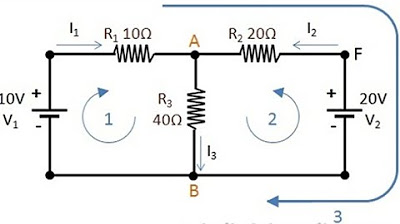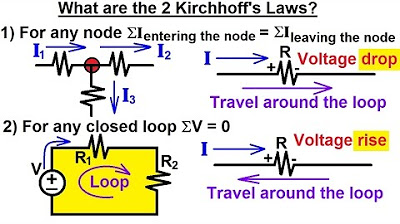Kirchhoff's voltage law | Circuit analysis | Electrical engineering | Khan Academy
Summary
TLDRThis video script explains Kirchhoff's Voltage Law (KVL) in the context of circuit analysis. It uses a simple circuit with a voltage source and resistors to demonstrate the concept of voltage rises and drops. The script clarifies that the sum of voltage rises minus the sum of voltage drops equals zero, which is KVL. It illustrates this with a single resistor and then generalizes it for circuits with multiple resistors, emphasizing that KVL applies regardless of the starting point or direction in the circuit loop.
Takeaways
- 🔌 Kirchhoff's Voltage Law (KVL) is a fundamental principle in circuit analysis.
- 📈 The law states that the algebraic sum of the voltage rises and drops in any closed loop of a circuit is zero.
- 🔢 A voltage source of 10 volts and a resistor of 200 ohms are used as an example in the script.
- 📉 The concept of voltage rise (going through a voltage source) and voltage drop (across a resistor) is explained.
- 🔄 The voltage drop is equal and opposite to the voltage rise, meaning they cancel each other out.
- 🔄 The voltage at any point in the circuit can be determined by the sum of the voltage rises and drops from a reference point.
- 🔗 KVL can be applied to any loop in a circuit, regardless of the starting point.
- 🔄 The law applies to circuits with multiple resistors, as demonstrated with two 100-ohm resistors.
- 🔢 The script provides a mathematical representation of KVL: v-rise - v-drop = 0.
- 🔧 KVL is a tool for circuit analysis, often used alongside Kirchhoff's Current Law (KCL).
Q & A
What is Kirchhoff's Voltage Law (KVL)?
-Kirchhoff's Voltage Law states that the sum of the voltage rises and the sum of the voltage drops around a closed loop in a circuit is always equal to zero.
How is voltage rise and voltage drop defined in the script?
-A voltage rise occurs when the voltage increases as you move through a component (e.g., a voltage source), while a voltage drop occurs when the voltage decreases, such as when passing through a resistor.
What happens to the total voltage when you go around a complete loop in a circuit?
-The total voltage rise minus the total voltage drop around a complete loop equals zero, meaning you return to the same voltage level you started with.
In the example circuit with one 200-ohm resistor and a 10-volt source, what are the voltage rises and drops?
-There is a voltage rise of 10 volts across the voltage source and a voltage drop of 10 volts across the 200-ohm resistor.
What does the script mean by 'v-rise minus v-drop equals zero'?
-It means that the total voltage gained from voltage rises equals the total voltage lost from voltage drops, which is the essence of Kirchhoff's Voltage Law.
How does the circuit behave when two 100-ohm resistors are added to the 10-volt source?
-The circuit has a 10-volt rise at the source and two voltage drops of 5 volts each across the two resistors, summing to zero when completing the loop.
How do you label node voltages in a circuit?
-Node voltages are labeled relative to a reference point, often chosen as zero volts (ground). For example, the node connected to the positive terminal of a 10-volt source is labeled as 10 volts.
Can Kirchhoff's Voltage Law be applied if we start at any point in the circuit?
-Yes, KVL applies no matter where you start in the loop, and no matter the direction in which you traverse the loop.
What happens if you go counterclockwise instead of clockwise around the circuit?
-The voltage rises and drops will still sum to zero, regardless of the direction you go around the loop.
What tools are mentioned for circuit analysis alongside Kirchhoff's Voltage Law?
-Kirchhoff's Voltage Law is paired with Kirchhoff's Current Law (KCL) to form essential tools for analyzing circuits.
Outlines

This section is available to paid users only. Please upgrade to access this part.
Upgrade NowMindmap

This section is available to paid users only. Please upgrade to access this part.
Upgrade NowKeywords

This section is available to paid users only. Please upgrade to access this part.
Upgrade NowHighlights

This section is available to paid users only. Please upgrade to access this part.
Upgrade NowTranscripts

This section is available to paid users only. Please upgrade to access this part.
Upgrade Now5.0 / 5 (0 votes)





